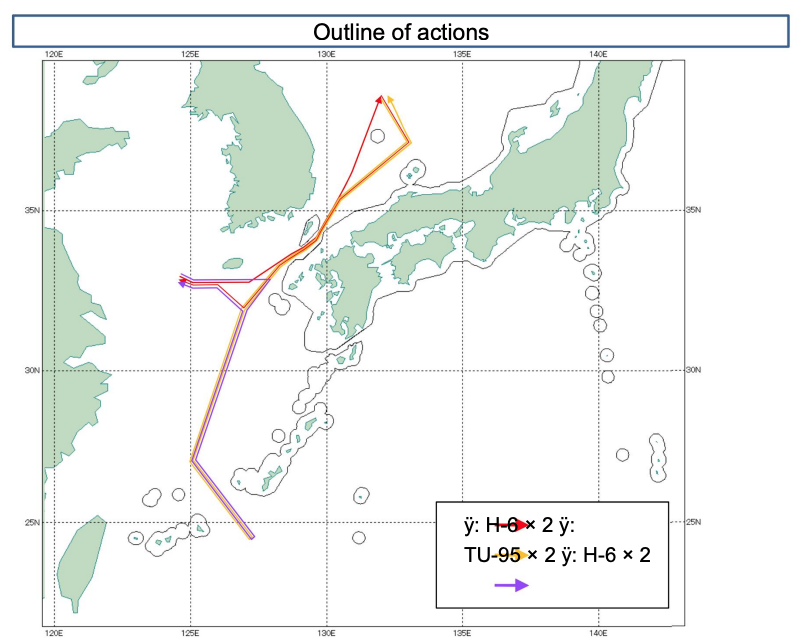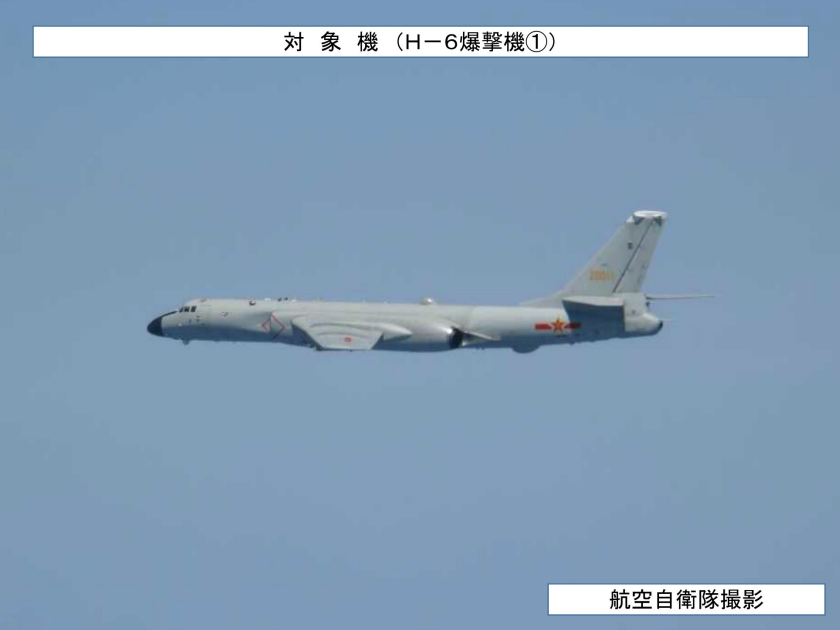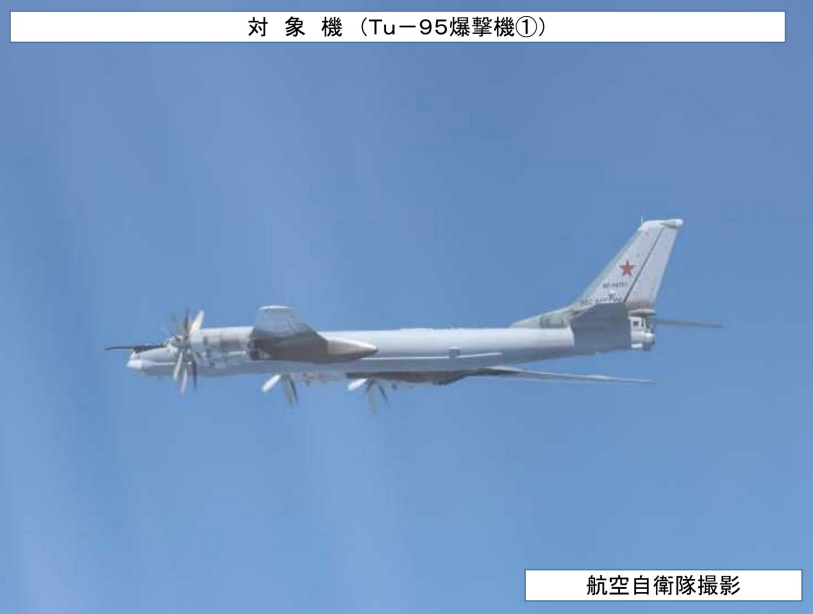
Four Chinese H-6 bombers and two Russian Tu-95 bombers conducted joint flights together on Tuesday around Japan and the Republic of Korea, prompting both countries to scramble fighter aircraft to monitor the flights. The joint flights took place the same day U.S. President Joe Biden was meeting his Australian, Indian and Japanese Quad grouping counterparts in Tokyo, though both the Russian and Chinese defense ministries stated that the flights were part of their annual military cooperation plan and not directed towards anyone.
Japan Defense Minister Nobuo Kishi, in a press conference on Tuesday, stated that the flight was provocative and that Japan had registered its concerns via diplomatic channels. Kishi also stated that as the international community responds to Russia’s invasion of Ukraine, China’s continuing joint military activities with Russia could not be overlooked, adding that this also showed that the security environment around Japan was becoming more tense. Kishi noted that this was the fourth joint flight since 2019 and the first since last November.
The Joint Staff Office (JSO) of Japan’s Defense Ministry issued a release on Tuesday stating that from morning to afternoon that day two Chinese H-6 bombers flew from the East China Sea to the Sea of Japan, joining two Russian Tu-95 bombers there. The four aircraft flew together to the East China Sea. Two other Chinese H-6 bombers replaced the two flying in formation with the Russian planes. The formation then flew through the Miyako Strait into the Pacific Ocean and later returned the same way. The JSO also said a Russian IL-20 surveillance aircraft flew from morning until afternoon the same day over the Sea of Japan from Rebun Island in Hokkaido to Noto Peninsula, Honshu and that for all the flights Japan Air Self Defense Force fighter aircraft were scrambled to conduct surveillance.

The ROK’s Joint Chiefs of Staff (JCS) issued a text message to journalists stating that two Chinese and four Russian warplanes entered the Korean Air Defense Identification Zone (KADIZ), but did not violate South Korea’s territorial airspace, reported Yonhap News Agency on Tuesday. Yonhap also quoted the JCS saying, “Prior to their entry into the KADIZ, our military deployed Air Force fighters to conduct tactical steps in preparation against potential accidental situations,” and that at 7:56 a.m., two Chinese H-6 bombers entered the KADIZ from an area 126 kilometers northwest of Ieodo, a submerged rock south of the southern island of Jeju. The planes moved toward the East Sea (Korea’s name for the Sea of Japan) and exited the zone at around 9:33 a.m. Later, the two Chinese planes joined four Russian planes, including two Tu-95 bombers, and entered the KADIZ together at 9:58 a.m. They then left the zone at 10:15 a.m. At around 3:40 p.m., four Chinese and two Russian military aircraft were spotted flying in an area some 267 km southeast of Ieodo which lay outside the KADIZ.
Although the JCS did say what the two other Russian planes were, Russia’s defense ministry said in a press release Tuesday that Russian Su-30SM fighters provided support for the air task force during the joint air patrol.
“The Russian Aerospace Force and the Air Force of the Chinese People’s Liberation Army conducted a joint air patrol in the Asia-Pacific region,” Russia’s media statement said. “The air task force composed of Tu-95MS strategic missile-carrying bombers of the Russian Aerospace Force and Hong-6K strategic bombers of the Air Force of the Chinese People’s Liberation Army conducted a joint air patrol over the waters of the Sea of Japan and the East China Sea. …In the process of accomplishing their tasks, the aircraft of both countries operated strictly in compliance with the provisions of international law. There were no violations of the airspace of foreign states.”
The Russian MOD release also stated that the joint air patrol by the Russian and Chinese strategic bombers was conducted under the 2022 plan of military cooperation and was not aimed against third countries, adding that the flights lasted 13 hours. During some stages of the flights, the release said, the bombers were escorted by fighter jets of the Republic of Korea Air Force (ROKAF) and JASDF.
The Chinese Ministry of National Defense on Tuesday issued a brief statement stating, “According to the annual military cooperation plan between the Chinese and Russian militaries, on May 24, the air forces of the two countries organized routine joint air strategic patrols over the Sea of Japan, the East China Sea and the Western Pacific Ocean”. On Wednesday, Senior Colonel Wu Qian, spokesperson for the Ministry of National Defense of China, stated that “On May 24, the air forces of China and Russia carried out a routine joint air strategic cruise in 2022. This is the fourth strategic cruise jointly implemented by the air forces of the two countries since 2019. The purpose is to test and improve the level of cooperation between the air forces of the two countries and promote strategic mutual trust and practical cooperation between the two militaries. This action is not aimed at a third party and has nothing to do with the current international and regional situation”.

Earlier on Monday, the JSO issued two releases on the movements of People’s Liberation Army Navy (PLAN) ships around Japan, the first release stated that on 1 p.m. on Sunday, a PLAN Type 054A frigate was sighted traveling southeast about 260 km west of Fukue Island. On Monday at 7 a.m. a second Type 054A was sighted moving northeast about 120 km southwest of Tsushima. The two ships then proceeded northeast through the Tsushima Strait and sailed toward the Sea of Japan. Images and pennant numbers provided in the release identified the PLAN frigates as CNS Xuzhou (530) and CNS Handan (579). The release stated that the Japan Maritime Self Defense Force (JMSDF) fast attack craft JS Otaka (PG-826) and minesweeper JS Ukushima (MSC-686) along with a JMSDF P-1 Maritime Patrol aircraft of Fleet Air Wing 4 based at Naval Air Facility Atsugi monitored the ships.
The second release stated that at around 10 a.m. on Monday, May 23, a PLAN Sovremenny-class destroyer was seen 80 km northwest of Kume Island.he ship proceeded southeast through the Miyako Strait and sailed toward the Pacific Ocean. The pennant number provided identified the ship as CNS Hangzhou (136). A JMSDF P-3C Orion Maritime Patrol Aircraft of Fleet Air Wing 5 based at Naha Air Base monitored the PLAN ship.
On Wednesday the JSO issued two releases stating that all three ships had returned to the East China Sea. The first release stated that a PLAN Type 054A frigate was sighted around 4 p.m. on Tuesday traveling southwest about 120 km northeast of Tsushima (Nagasaki Prefecture), and on the same day, at around 7 p.m., another Type 054A frigate was sighted going southwest at 90 km northwest of the Oki Islands. The release stated that the two frigates sailed southwest through the Tsushima Strait into the East China Sea. Otaka, Ukushima and minesweeper JS Sugashima (MSC-681), along with a JMSDF P-1 maritime patrol aircraft, monitored the ships. The second release stated that at 1 a.m. on Wednesday a PLAN Sovremenny class destroyer was sighted traveling northwest in the waters about 130 km east of Miyako island and subsequently sailed northwest through the Miyako Strait into the East China Sea. The releases stated that the frigates and destroyer were the same ships cited in Monday’s release and that the ship was monitored by the support ship JS Amakusa (AMS-4303) and a JMSDF P-3C Orion.





